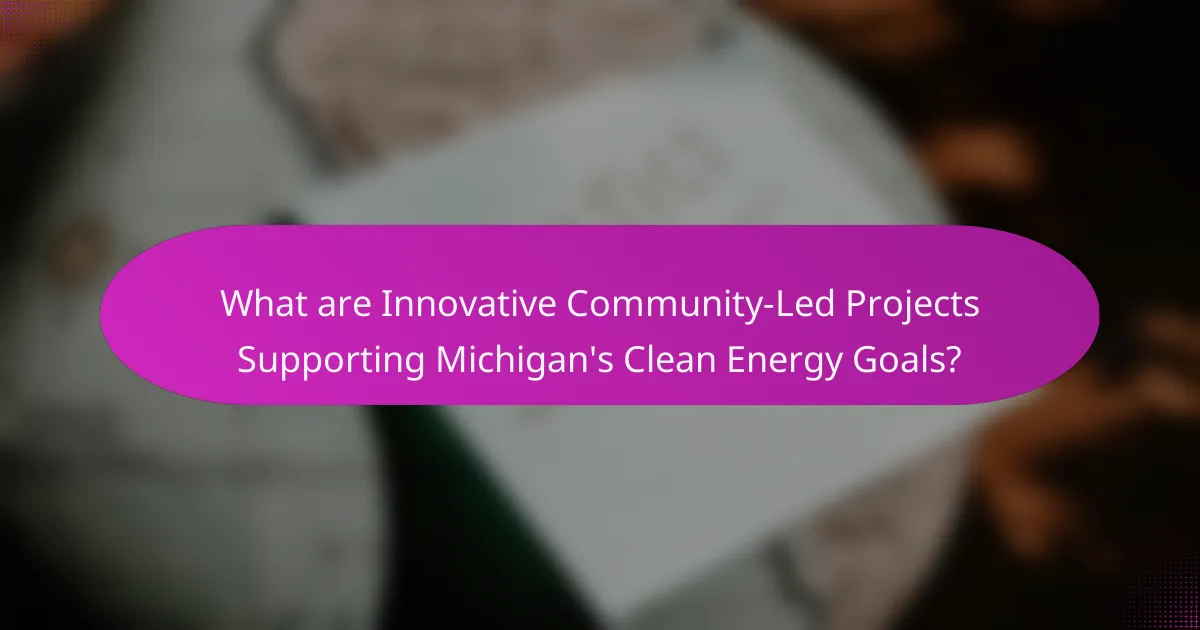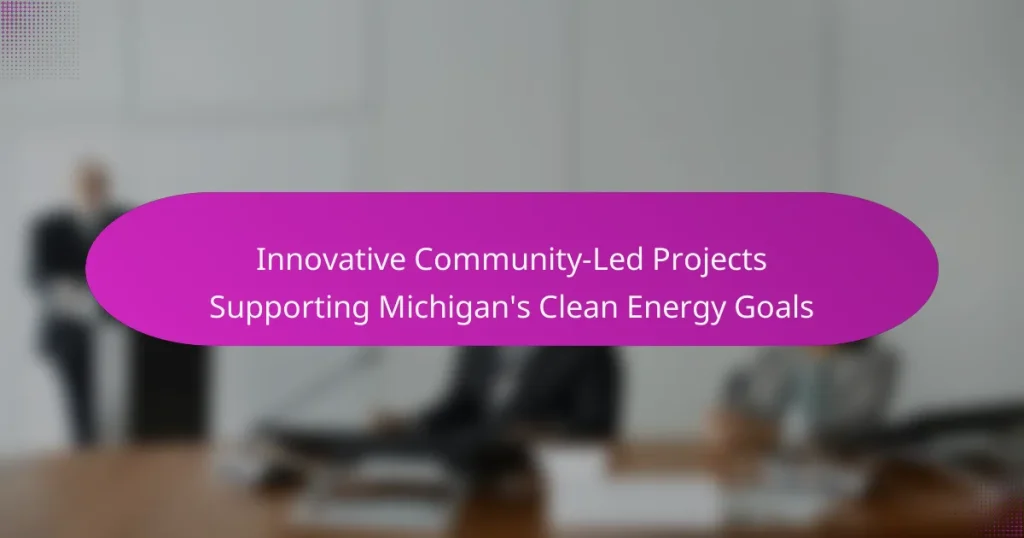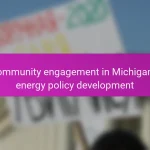
What are Innovative Community-Led Projects Supporting Michigan’s Clean Energy Goals?
Innovative community-led projects in Michigan are initiatives aimed at achieving clean energy goals. These projects often involve local stakeholders in the planning and implementation processes. Examples include community solar programs that allow residents to share renewable energy resources. Another example is energy efficiency retrofitting in public buildings, which reduces consumption and emissions. Local governments frequently collaborate with non-profits to promote sustainable practices. These efforts contribute to the state’s commitment to reducing greenhouse gas emissions by 28% by 2025. The Michigan Department of Environment, Great Lakes, and Energy supports these initiatives through funding and resources. Engaging communities fosters greater awareness and participation in clean energy solutions.
How do these projects align with Michigan’s clean energy objectives?
These projects align with Michigan’s clean energy objectives by promoting renewable energy sources and reducing carbon emissions. They focus on community engagement and local solutions. For instance, initiatives like solar panel installations directly contribute to increasing the state’s renewable energy capacity. According to the Michigan Department of Environment, Great Lakes, and Energy, the state aims for a 50% reduction in greenhouse gas emissions by 2030. Community-led projects support this goal by fostering sustainable practices. Additionally, these projects often incorporate energy efficiency measures, further decreasing overall energy consumption.
What specific clean energy goals are being targeted by these projects?
The specific clean energy goals targeted by these projects include reducing greenhouse gas emissions. They aim to achieve a 26% reduction in emissions by 2025. Additionally, the projects focus on increasing renewable energy usage to 50% by 2030. Another goal is to enhance energy efficiency across communities. This includes initiatives to retrofit buildings for better energy performance. The projects also promote the use of electric vehicles to decrease reliance on fossil fuels. By 2030, the goal is to have a significant increase in electric vehicle adoption. These targets align with Michigan’s broader commitment to sustainability and clean energy transition.
How do community-led initiatives differ from traditional energy projects?
Community-led initiatives prioritize local engagement and decision-making, differing fundamentally from traditional energy projects. Traditional energy projects often involve top-down approaches driven by large corporations or government entities. These projects typically focus on maximizing profits and efficiency, sometimes overlooking community needs. In contrast, community-led initiatives emphasize collaboration among local stakeholders. They aim to address specific community energy needs and preferences, fostering a sense of ownership. Research indicates that community-led projects can enhance social cohesion and local economic development. For example, studies show that such initiatives often lead to increased participation in energy conservation efforts. This engagement can result in a more sustainable energy future tailored to local contexts.
Why are community-led projects important for clean energy in Michigan?
Community-led projects are crucial for clean energy in Michigan because they empower local populations to take charge of their energy solutions. These initiatives often reflect the specific needs and values of the community. They foster greater public engagement and awareness about renewable energy sources. Studies show that local involvement can lead to higher adoption rates of clean energy technologies. For instance, community solar projects allow residents to benefit from renewable energy without the need for individual solar panels. Furthermore, these projects can stimulate local economies by creating jobs in installation and maintenance. They also promote energy resilience by diversifying energy sources and reducing reliance on fossil fuels. Overall, community-led projects enhance the effectiveness of Michigan’s clean energy goals through localized support and innovation.
What role do local communities play in achieving clean energy goals?
Local communities play a crucial role in achieving clean energy goals through grassroots initiatives and local engagement. They contribute by implementing renewable energy projects, such as solar installations and wind farms. Community members often advocate for policies that support clean energy development. Local organizations can facilitate education and awareness about energy conservation and sustainability. Collaborations between residents, local governments, and businesses can lead to innovative solutions tailored to specific community needs. For example, Michigan has seen successful community-led projects that enhance energy efficiency and promote renewable resources. These efforts not only reduce carbon footprints but also foster economic growth and job creation in local areas.
How do these projects foster community engagement and awareness?
These projects foster community engagement and awareness by actively involving local residents in clean energy initiatives. They encourage participation through workshops and informational sessions. Community members gain knowledge about renewable energy options available in Michigan. Projects often feature collaboration with local organizations, enhancing trust and participation. Social media campaigns raise awareness about clean energy benefits. Surveys and feedback mechanisms allow residents to voice their opinions and needs. These interactions create a sense of ownership and responsibility towards clean energy goals. Evidence shows that engaged communities are more likely to adopt sustainable practices, aligning with Michigan’s clean energy objectives.
What challenges do these projects face in Michigan?
Innovative community-led projects in Michigan face several challenges. Funding limitations hinder project development and sustainability. Regulatory hurdles complicate the implementation of clean energy solutions. Community engagement varies, affecting participation and support. Technical expertise may be lacking in some local organizations. Additionally, infrastructure constraints can impede project execution. Climate variability poses risks to project reliability and effectiveness. Lastly, competition for resources among various initiatives can dilute focus and impact.
What are the common obstacles to implementing community-led clean energy projects?
Common obstacles to implementing community-led clean energy projects include funding challenges, regulatory barriers, and community engagement issues. Funding is often limited, making it difficult to initiate and sustain projects. Regulatory barriers can include complex permitting processes and inconsistent policies. Community engagement issues arise when local stakeholders are not adequately informed or involved in decision-making. According to a report by the National Renewable Energy Laboratory, these factors can significantly hinder project development.
How can these challenges be overcome?
Challenges in innovative community-led projects can be overcome through strategic collaboration and resource allocation. Engaging local stakeholders fosters a sense of ownership and commitment. Establishing partnerships with educational institutions enhances knowledge sharing. Securing funding from government grants and private investors provides necessary financial support. Implementing pilot programs allows for testing and refinement of ideas. Utilizing technology improves efficiency and outreach. Regular community meetings ensure transparency and gather feedback. These methods collectively address obstacles and promote successful project implementation.
What successful examples of community-led projects exist in Michigan?
Successful examples of community-led projects in Michigan include the Detroit Solar Project and the Michigan Energy Options initiative. The Detroit Solar Project involves local residents installing solar panels on homes. This project has increased access to renewable energy for low-income communities. The Michigan Energy Options initiative focuses on energy efficiency improvements in homes and businesses. It has helped reduce energy consumption statewide. Both projects demonstrate community engagement and contribute to Michigan’s clean energy goals.
What innovative approaches have been used in these projects?
Innovative community-led projects in Michigan’s clean energy initiatives have employed several unique approaches. These include community solar programs that allow residents to invest in shared solar arrays. They also feature energy efficiency retrofitting programs tailored for low-income households. Additionally, projects have integrated local workforce development, training residents for jobs in renewable energy sectors. Some initiatives utilize smart technology for energy management, enhancing efficiency and reducing costs. Collaborative partnerships between local governments and organizations have been pivotal in these projects. These partnerships often leverage funding from state and federal resources. Furthermore, community engagement strategies have been essential in raising awareness and participation. These innovative methods collectively advance Michigan’s clean energy goals while fostering community resilience.
How have these projects impacted local communities and the environment?
Innovative community-led projects supporting Michigan’s clean energy goals have positively impacted local communities and the environment. These projects have created job opportunities, enhancing economic stability in the regions. For instance, the installation of solar panels has led to the creation of over 1,000 jobs in Michigan. Additionally, community engagement in renewable energy initiatives has fostered a sense of ownership and pride among residents. Environmentally, these projects contribute to reduced greenhouse gas emissions. The transition to clean energy sources has decreased reliance on fossil fuels, improving air quality. Research indicates that areas implementing these projects have seen a 20% reduction in local carbon emissions. Overall, these initiatives support sustainable development while benefiting both communities and the environment.
What resources are available for communities to start their own clean energy projects?
Communities can access various resources to start clean energy projects. These include grants from state and federal programs. The U.S. Department of Energy offers funding opportunities specifically for community initiatives. Local governments often provide support through technical assistance and policy frameworks. Nonprofit organizations also offer resources, including educational materials and project planning tools. Additionally, partnerships with universities can provide research support and expertise. The Michigan Energy Office provides specific guidance tailored to Michigan communities. These resources collectively empower communities to implement effective clean energy solutions.
What funding opportunities exist for community-led clean energy initiatives?
Funding opportunities for community-led clean energy initiatives include federal grants, state programs, and private investments. The U.S. Department of Energy offers funding through various initiatives like the Solar Energy Technologies Office and the Wind Energy Technologies Office. Michigan’s Clean Energy Fund provides financial assistance to local projects that promote renewable energy. Additionally, organizations like the Michigan Energy Office support community-based clean energy projects. Nonprofits and foundations may also offer grants specifically for clean energy initiatives. These funding sources are designed to enhance community resilience and promote sustainability in energy practices.
How can communities access technical assistance and expertise?
Communities can access technical assistance and expertise through various channels. Local government agencies often provide resources and support for community projects. Nonprofit organizations also offer technical assistance tailored to community needs. Universities and research institutions may collaborate with communities to share expertise and knowledge. Additionally, online platforms and networks can connect communities with experts in clean energy. These resources help communities implement innovative projects effectively. Access to such assistance is crucial for achieving clean energy goals in Michigan.
What best practices can communities follow to ensure the success of their clean energy projects?
Communities can ensure the success of their clean energy projects by engaging stakeholders early in the planning process. Involving local residents and businesses fosters support and collaboration. Establishing clear goals and objectives is essential for guiding project development. Communities should also conduct thorough feasibility studies to assess potential impacts and benefits. Securing diverse funding sources can enhance project viability and sustainability. Implementing transparent communication strategies builds trust and keeps the community informed. Regularly evaluating project progress allows for adjustments and improvements. Lastly, sharing success stories and lessons learned can inspire future initiatives and strengthen community commitment to clean energy.
How can communities effectively engage stakeholders in their projects?
Communities can effectively engage stakeholders in their projects by fostering open communication and collaboration. Establishing clear channels for dialogue encourages stakeholders to share their insights and concerns. Regular meetings and workshops can facilitate this interaction, allowing stakeholders to feel included in the decision-making process. Utilizing surveys and feedback tools can also gather valuable input from a wider audience.
Research shows that inclusive engagement leads to better project outcomes. A study by the International Association for Public Participation indicates that projects with stakeholder involvement are more likely to succeed. By actively involving stakeholders, communities can align their projects with the needs and expectations of those they serve. This approach builds trust and encourages ongoing participation.
What strategies can be employed to measure the impact of these initiatives?
Surveys and questionnaires can be employed to measure the impact of community-led clean energy initiatives. These tools gather feedback from participants regarding their experiences and satisfaction levels. Tracking energy consumption data before and after project implementation provides concrete evidence of changes in energy usage. Analyzing local economic indicators, such as job creation and investment, can highlight the economic benefits of these initiatives. Community engagement metrics, like participation rates in events or programs, help assess the level of community involvement. Collaborating with local universities for research studies can yield in-depth analyses of project outcomes. Case studies documenting specific initiatives can illustrate successful practices and lessons learned. Regular reporting on environmental metrics, such as reductions in carbon emissions, can quantify the ecological impact of these projects.
Innovative community-led projects in Michigan focus on achieving the state’s clean energy goals by involving local stakeholders in renewable energy initiatives. Key examples include community solar programs and energy efficiency retrofitting, which aim to reduce greenhouse gas emissions and promote sustainable practices. These projects align with Michigan’s targets of a 26% reduction in emissions by 2025 and a 50% increase in renewable energy usage by 2030, while fostering community engagement and economic development. Challenges such as funding limitations and regulatory barriers are addressed through strategic collaboration and resource allocation, enhancing the effectiveness and sustainability of these initiatives.


